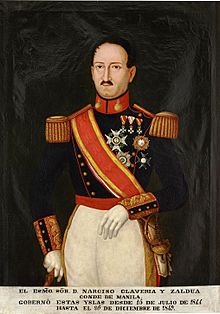Narciso Clavería y Zaldúa facts for kids
Quick facts for kids
Lieutenant General
The Most Excellent The Count of Manila
|
|
|---|---|
 |
|
| 71st Governor-General of the Philippines | |
| In office July 16, 1844 – December 26, 1849 |
|
| Monarch | Isabella II of Spain |
| Preceded by | Francisco de Paula Alcalá de la Torre |
| Succeeded by | Antonio María Blanco |
| Personal details | |
| Born | May 2, 1795 Girona, Catalonia, Spain |
| Died | June 20, 1851 (aged 56) Madrid, Spain |
| Spouses | Ana Berroeta Clavería, Countess of Manila |
Narciso Clavería y Zaldúa (born May 2, 1795 – died June 20, 1851) was a Spanish army officer. He served as the Governor-General of the Philippines from 1844 to 1849.
Clavería was known as a leader who wanted to make things better and more modern. He traveled across many provinces to understand what people needed. He helped farming, improved streets in Manila, and made the country better. He was given the special title of Count of Manila. Several towns in the Philippines are named after him, like Claveria in Misamis Oriental, Claveria in Masbate, and Claveria in Cagayan.
His grandson, Narciso Clavería y de Palacios, 3rd Count of Manila, became a famous architect. He designed the Toledo Railway Station in Spain.
Contents
Early Life and Career
Narciso Clavería was born in Girona, a city in Catalonia, Spain. His mother was from the Basque region. He joined Spain's army staff in 1838. He quickly rose through the ranks, becoming a colonel in 1839 and a lieutenant general in 1844. On July 16, 1844, he became the governor of the Philippines.
Key Actions as Governor-General
Changing the Philippine Calendar
For many years, the Philippines was one day behind the calendars of Asia, Europe, and America. This happened because when Ferdinand Magellan sailed west around the world, he gained time each day. This meant his calendar ended up a day behind. Clavería and the Archbishop of Manila decided to fix this. They removed Tuesday, December 31, 1844, from the calendar. So, the day after Monday, December 30, 1844, became Wednesday, January 1, 1845. This made the Philippines' calendar match the rest of the world.
Giving Surnames to Filipinos
Before Clavería's time, many Filipinos did not have surnames. This caused a lot of confusion, especially for official records. On November 21, 1849, Clavería issued an important order. He sent long lists of Spanish and local surnames to leaders in different provinces. These names were then given to people who didn't have surnames. In some towns, all the new surnames given to people started with the same letter. For example, people in Alimodian might have received names starting with "A," while those in Miagao received names starting with "M."
Introducing Steamships
The first steam-powered warships to sail regularly in Philippine waters arrived in 1848. These ships were named Magallanes, Elcano, and Reina de Castilla. They were very important because they could chase and catch the fast boats of the Moro pirates. These pirates often attacked coastal villages from the South. The new steamships helped protect the people and their homes.
Fighting Pirates in Balanguingui
Clavería led a military mission against pirates living on the Samal Islands. He attacked and destroyed several towns and forts on the island of Balanguingui. This island is located between Basilan and Jolo. In 1848, his forces freed 130 captives, including Filipinos and Dutch people from Java. For this successful mission, he was given the titles of Count of Manila and Viscount of Clavería. He also received a high honor called the Knight Grand Cross of Royal and Military Order of San Fernando from Queen Isabella II.
Improving Provincial Governors
In the past, the leader of a province was both a governor and a judge. They also controlled trade in their area. This meant they had too many jobs and sometimes didn't rule well. They often didn't know much about law, so important cases had to be sent to Manila. This caused long delays in getting justice. Clavería ordered that governors should have at least two years of experience in law. He also said that governors should not be involved in trade. This rule helped make the government fairer, though it took many years to be fully followed.
Other Achievements During His Term
During Clavería's time, many new things happened. A social club called "Sociedad de recreo" (Recreation Association) was started in October 1844. He also got approval to create a military library in February 1846. In 1848, a monument to Ferdinand Magellan was built on the south bank of the Pasig River. Clavería's time as governor was very busy. Several newspapers were started, including La Esperanza (the first daily newspaper in Manila) in December 1846, and Diario de Manila in 1848.
Return to Spain
In 1849, Clavería asked to retire from his position. He left the Philippines and returned to Spain. He was known as a cultured, honest, and hardworking man. In 1850, he became a senator, but he passed away the next year, on June 20, 1851, in Madrid.
See also
 In Spanish: Narciso Clavería y Zaldúa para niños
In Spanish: Narciso Clavería y Zaldúa para niños

